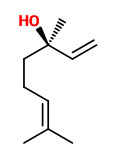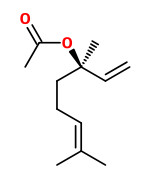Dies ist eine alte Version des Dokuments!
Mentha citrata Ehrh. - syn. Mentha aquatica L. var.citrata (Ehrh.) Fresen. - Lamiaceae
bergamot mint, eau-de-cologne mint, lemon mint, orange mint, Bergamott-Minze
“Mentha citrata oil is a pale yellow or pale olive colored to almost water-white liquid of a sweet-herbaceous, somewhat fruity-fresh odor type; it resembles bergamot, but is distinctly more harsh in its terpenic topnotes, less rich in body, and without the oily-sweet, candy-like undertone of good bergamot oils. On the other hand, mentha citrata, oil presents a certain bergamot note without the citrus notes. This makes the oil more interesting in the lavender-fougere field. Its dryout has some resemblance to sage clary, but lacks the richness of that oil.”
[Arctander, Steffen. Perfume and flavor materials of natural origin, 1960, 415-416]
The strong lavender odor of the Bergamot Mint, Mentha citrata Ehrh., is due to two principal oil constituents, linalyl acetate and linalool, that make up 84-90% of the oil.
[Todd, W. A., and M. J. Murray. „New essential oils from hybridization of Mentha citrata Ehrh.“ Perfumary and Essential Oil Record 59 (1968): 97-102]
Of the fourteen components representing more than 90% of the total essential oil of Mentha citrata Ehrh. plants collected in Argentina, the main compounds were linalool (23.8-35.4%) and linalyl acetate (48.7-60.9%).
[Malizia, Rubén A., et al. „Essential oil of Mentha citrata grown in Argentina. Variation in the composition and yield at full-and post-flowering.“ Journal of Essential Oil Research 8.4 (1996): 347-349]
„The major components of the essential oil and pentane extract were linalyl acetate (21.46%; 42.02%), linalool (13.68%; 22.66%), 1,8-cineole (12.51%; 6.40%), β-myrcene (8.10%; 2.87%), α-terpineol (7.38%; 0.73%) and geranyl acetate (8.66%; 1.76%). The major components of the volatile aglycones were 1-octen-3-ol (40.28%), eugenol (12.29%), 3-octanol (7.09%), linalool (4.59%), benzyl alcohol (3.71%), 2-phenylethanol (3.67%), 3-hexene-1-ol (2.87%) and 1-heptene-3-ol (2.88%). Compared with free volatile compounds (essentia1 oil: 1.56%; pentane extract: 1.64% ), the glycosidically bound volatiles were present in a lower concentration, about 0.0068%.“
[Mastelić, Josip, Mladen Miloš, and Danica Kuštrak. „Free and glycosidically bound volatiles of Mentha citrata ehrh.“ Croatica chemica acta 73.3 (2000): 781-794] https://hrcak.srce.hr/file/194966
„Mentha citrata Ehrh. (bergamot mint; Lamiaceae) produces an essential oil containing only the acyclic monoterpenol (−)-3R-linalool and its acetate ester. A cloning strategy based upon the assumption that the responsible monoterpene synthase would resemble, in sequence, monoterpene cyclases from this plant family yielded a cDNA encoding the (−)-3R-linalool synthase. The nucleotide sequence of this monoterpene synthase is similar to those of several monoterpene cyclases from the mint (Lamiaceae) family (62–72% identity), but differs substantially from that of 3S-linalool synthase from Clarkia (41% identity; this composite gene appears to be of recent origin) and from that of 3R-linalool synthase from Artemisia (52% identity; the functional role of this gene is uncertain).“
[Crowell, Anastasia L., et al. „Molecular cloning and characterization of a new linalool synthase.“ Archives of biochemistry and biophysics 405.1 (2002): 112-121]


